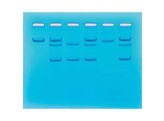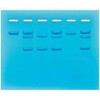Sickle Cell Gene Detection (DNA-based)
Sickle Cell Anemia is a common genetic disease that causes long rods in red blood cells, giving them a "sickled" appearance. These cells get stuck in small capillaries of the blood stream leading to oxygen deprivation that causes pain and organ damage. Sickle Cell Anemia is caused by a single point mutation in the hemoglobin gene that results in a faulty protein. In this experiment, your students will investigate the restriction enzyme that discriminates between HbA (normal) and HbS (disease) genes and perform a simulated test on a patient.
• Discover how a single nucleotide mutation can profoundly affect a person’s health
• Explore Mendelian genetics and the molecule methods used to identify sickle cell disease
• Perform agarose gel electrophoresis to separate differently-sized DNA molecules
• Load, run, analyze, and size control samples and samples from a family of three to identify mutations in their hemoglobin genes
Sickle Cell Anemia is a common genetic disease that causes long rods in red blood cells, giving them a "sickled" appearance. These cells get stuck in small capillaries of the blood stream leading to oxygen deprivation that causes pain and organ damage. Sickle Cell Anemia is caused by a single point mutation in the hemoglobin gene that results in a faulty protein. In this experiment, your students will investigate the restriction enzyme that discriminates between HbA (normal) and HbS (disease) genes and perform a simulated test on a patient.
• Discover how a single nucleotide mutation can profoundly affect a person’s health
• Explore Mendelian genetics and the molecule methods used to identify sickle cell disease
• Perform agarose gel electrophoresis to separate differently-sized DNA molecules
• Load, run, analyze, and size control samples and samples from a family of three to identify mutations in their hemoglobin genes
Properties
- F778116
- 116




